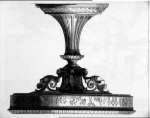Cast iron technique from China
Chinese people know how to use blast furnaces to cook cast iron right from the fourth century BC. The reason for the previous step is due to many reasons. China has a very good refractory clay to build a blast furnace. The Chinese also know how to lower the melting temperature of iron. They poured into the blast furnace a substance they called "black soil" that was rich in iron phosphate. If 6% phosphorus is added to the iron mixture, the normal melting temperature of 1,130 degrees will be reduced to 950 degrees. The technique was used in China in the early days, after which it was abolished when the improvement of the blast furnace for steel did not need to be used anymore.
Coal for higher temperatures has been used as fuel for blast furnaces since at least the fourth century AD. One of the cast iron methods is to place iron ore into long tubular bands, covering the pot with coal and burning. This technique has the added benefit of eliminating sulfur from the cast iron process.
 The widespread use of cast iron in ancient China resulted in many important consequences , such as the use of cast iron plows to cultivate together with other iron tools such as scrapers. At that time, there were also knives, scissors, axes, saws and iron punchers. Food is cooked in cast iron pots, and even toys are made of cast iron. In the tomb of the Han Dynasty from the 2nd century BC to the 2nd century AD there were statuettes of animal cast iron. People also found cast iron molds from the fourth century BC. But this mold may have been used to cast hoes and axes, copper or iron.
The widespread use of cast iron in ancient China resulted in many important consequences , such as the use of cast iron plows to cultivate together with other iron tools such as scrapers. At that time, there were also knives, scissors, axes, saws and iron punchers. Food is cooked in cast iron pots, and even toys are made of cast iron. In the tomb of the Han Dynasty from the 2nd century BC to the 2nd century AD there were statuettes of animal cast iron. People also found cast iron molds from the fourth century BC. But this mold may have been used to cast hoes and axes, copper or iron.
The sophisticated cast iron technique has allowed the casting of very thin walls and births that other forging techniques cannot. Thin-walled births are an indispensable tool in mass-produced salt by evaporating salt water and this leads Chinese people to exploit natural gas with deep drilling errors. to use that energy in salt making. This profession grew to a large scale when the Han nationalized it together with the iron profession in 119 BC. Thus, the profession of salt making and gas exploitation cannot be born without a cast iron craft.
In the 3rd century BC, the Chinese discovered that it could make cast iron flexible by annealing (ie keeping cast iron at high temperatures for about a week). The cast iron will not be too brittle, withstand impact, even strong bumps. That means that the plowshare will not break when it encounters large rocks. The annealed cast iron has almost the ductility of wrought iron, but is much more durable and tougher because it is cast. It is almost as good as steel.
Some of the achievements in China's iron casting industry have reached extraordinary levels, almost unbelievable even when we see it with our own eyes. For example, the Ngoc Tuyen tower in Duong Duong (Ho Bac) is entirely made of cast iron, built in 1601, 13m high. In 659 AD, Queen Vo Tac Thien made an eight-sided cast iron pillar , called Dai Chu Van Quoc, the merit of heavenly coins (the central pillar of the merit of Dai Chu in thousands of vassals). Column placed on a 6m high cast iron base, 51m circumference. The pole itself has a diameter of 3.6m and a height of 32m. At the top of the column is a 3 "high canopy of clouds", 9m in circumference, supporting four dragons of 3.6m in height, each with a gilded seed. Today we know that the total amount of metal used for presentation is about 1,345 tons.
The largest cast iron object was immediately poured into one block (the towers were clearly not a monolith) as the object was built according to the orders of King The Tong in the post-Chu Dynasty (951 - 960 AD) to celebrate the victory. Hung Noi in 954 AD. This extraordinary rich statue is 6m high, called the Great Architect in Thuong Chau (Ha Bac). It is hollow inside and has a thickness of 4-20cm.
- Mysterious iron pillar of 1,600 years old stainless steel
- 'Super Paper' is more durable than cast iron
- Producing artificial sand from waste iron from a cast iron factory
- Restoring the iron smelting technique that existed 2000 years ago
- A new way to treat broken bones: Bundle with 3D print material
- Ancient Egyptians made jewelry from meteorites
- Found traces of new forms of iron from the Antarctic universe
- China exposes its ambition of US $ 10,000 billion in space
- The first cast coins
- For the first time, Vietnam osteopaths with ultrasound
- Top 10 iron-rich foods
- Digital casts
 'Barefoot engineer' invents a pipeless pump
'Barefoot engineer' invents a pipeless pump Process of handling dead pigs due to disease
Process of handling dead pigs due to disease Radiometer
Radiometer Warp Engine: Technology brings us closer to the speed of light
Warp Engine: Technology brings us closer to the speed of light